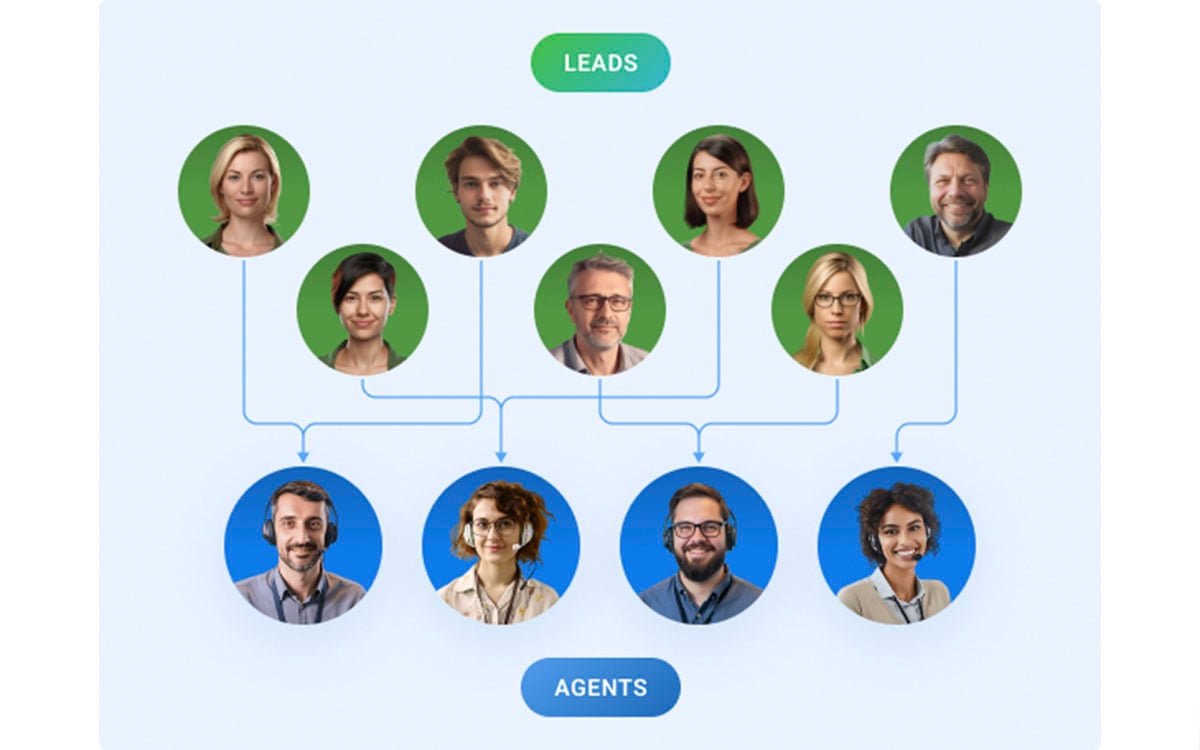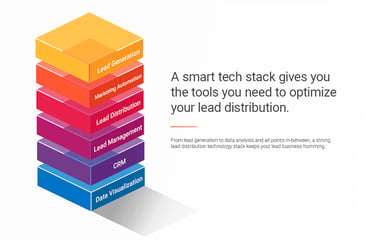Lead Routing: Software and Best Practices
Lead routing assigns leads to sales representatives or teams based on predefined rules and criteria.
Introduction
Lead generation is the lifeblood of business growth in marketing and sales. Companies invest substantial resources into attracting potential customers and converting them into qualified leads.
However, without an effective lead routing process, businesses struggle to distribute leads efficiently, leading to missed opportunities and decreased conversion rates. This article explores lead routing and software for lead generation, management, and distribution.
Lead Routing Software
There are various types of software available for lead routing. Many sales-oriented CRMs provide some level of lead routing. Dedicated lead management software provides more sophisticated routing. Most lead-routing software will integrate with CRMs and marketing automation platforms.
Whether a company uses a CRM, a lead management platform, or a combination of both, the fundamentals are the same.
Lead Generation: The Starting Point
Lead generation encompasses the strategies and tactics employed to attract potential customers and gather their information for further engagement. Whether through inbound marketing efforts, content creation, or paid advertising, generating leads is a fundamental step in the sales cycle. However, as the number of lead sources and channels increases, managing and distributing leads to your sales team becomes increasingly complex.
Depending on how leads are generated, they are routed directly to live sales agents or into lead nurturing. Inbound calls, texts, and chats go directly to sales reps, where there are either closed or moved into a nurture flow. Emails and form fills go straight into nurture sequences.
Lead Management: Nurturing and Qualifying Leads
Lead management involves nurturing and qualifying leads, ensuring they progress through the sales funnel effectively. Lead management includes lead capture, nurture, and qualification to determine conversion potential. Efficient lead routing ensures that different lead types are delivered to the right teams or agents.
A robust lead management system uses automation to simplify and reduce manual tasks. Lead management software such as LeadManager takes captured leads through the nurture and sales engagement phases.

Lead Routing: Maximizing Conversion Potential
An effective lead distribution process is crucial for maximizing conversion potential. When leads are promptly and intelligently distributed to the most suitable sales representatives, the chances of conversion significantly increase. There are various lead distribution methods, such as round-robin, weighted distribution, and pull.
Each approach has advantages and considerations. However, the underlying goal is the same: delivering leads to the right reps based on predefined criteria.
The choice between round-robin, weighted distribution, and predictive routing depends on your team's specific situation and goals. Here's when you might use each:
Round-Robin Lead Distribution:
This is a straightforward method to distribute leads, where each salesperson gets one lead at a time in a rotating order. This method is beneficial when all sales representatives have similar skill levels and capacities. It ensures every agent gets an equal opportunity and reduces the risk of neglected leads due to an imbalanced workload. However, this is not the best method if there are vast disparities in the performance of your sales team.
Weighted Distribution:
Weighted distribution is useful when there's a significant difference in sales reps' skill levels, capacities, or specialties. More weight (and thus more leads) are assigned to higher-performing reps or those with specific expertise relevant to the leads. It helps ensure that your most competent representatives handle the most leads, potentially increasing the chances of conversion. However, it can lead to overloading of certain individuals if not managed properly.
Shotgun Distribution:
Shotgun distribution is a method of simultaneously distributing leads to all available sales representatives. Once a lead enters the system, it is pushed to every sales rep. The first one to claim or respond to the lead takes ownership.
This method encourages quick response times as reps compete to be the first to engage with the lead. However, it requires an efficient tracking and management system to ensure leads are promptly attended to and not overlooked.
Pull Distribution:
Pull distribution puts leads in a common pool. Sales representatives select which leads to follow up on based on their judgment, expertise, or availability. This method allows sales reps to manage their workload and select leads that they are best suited for.
Lead-pulling distribution requires a high level of trust to be effective. Sales reps have greater autonomy and more responsibility to produce. Pull distribution is ineffective for large, inexperienced, or overworked sales teams.
Lead Routing Strategy: Getting Leads to the Best Reps
Lead routing assigns or directs leads to the appropriate salesperson or team. It considers the skills, capacity, and geographical location of sales reps, and the lead's source, value, or specific needs. Lead routing ensures that the lead is handled by the person most capable of closing the sale.
Implementing a robust lead routing strategy offers several benefits for businesses:
1. Improved lead response time and customer experience:
Promptly routing leads to the right team, or representative ensures timely follow-ups. This enhances customer satisfaction and increases the likelihood of successful conversions.
2. Increased lead conversion rates and sales team efficiency:
By matching leads with the best-qualified sales representatives, lead routing optimizes conversion rates and ensures that valuable leads aren't lost.
3. Enhanced lead tracking and performance measurement:
A well-structured lead routing system allows for accurate tracking and measurement of lead performance. It provides valuable insights into the effectiveness of various lead sources and sales approaches.
4. Ability to prioritize leads based on criteria:
Lead routing enables businesses to prioritize leads based on quality, engagement level, and sales-readiness. This ensures sales teams focus on the most promising opportunities, maximizing conversion rates.
Lead Routing Best Practices
To leverage the full potential of lead routing, businesses should follow these best practices:
Segment leads based on demographics, behavior, and engagement level:
Businesses can tailor routing rules by segmenting leads, ensuring the most appropriate sales representatives handle each lead category.
Implement lead scoring models:
Lead scoring allows businesses to assign values to leads based on their characteristics and behaviors. Leads with higher scores can be routed to sales representatives with greater experience and expertise, improving the chances of successful conversions.
Integrate lead routing with CRM and marketing automation systems:
Integrating lead routing with CRM and marketing automation streamlines the process, automates lead distribution, and facilitates seamless data synchronization.
Regularly analyze and optimize lead routing rules and strategies. Businesses should regularly review and refine their lead routing rules to adapt to changing market dynamics and lead quality. Continuous optimization ensures that leads are distributed efficiently and aligned with business objectives.
Challenges and Considerations
While lead routing offers immense benefits, businesses must also address potential challenges and considerations:
Data accuracy: To ensure accurate lead routing, businesses must maintain clean and up-to-date lead data. Inaccurate or outdated information can lead to misrouting or mishandling leads, resulting in missed opportunities.
System integration: Integrating lead routing with existing CRM and marketing automation systems can be complex. It requires careful planning and coordination to ensure seamless data flow and system synchronization.
Scale: As businesses grow and their lead volume increases, scaling effectively becomes a concern. Lead routing systems should be able to handle a growing number of leads without compromising efficiency or performance.
Compliance and data privacy: Businesses must adhere to relevant compliance regulations and data privacy laws when implementing lead routing solutions. Ensuring the protection of customer data and obtaining proper consent are critical considerations.
Future Trends and Innovations
Looking ahead, several trends and innovations are shaping the future of lead routing:
Artificial intelligence and machine learning are transforming lead routing. AI and machine learning let advanced predictive algorithms analyze large amounts of data. These algorithms are then able to make intelligent routing decisions quickly.
Personalization and dynamic routing: Businesses increasingly leverage personalization techniques to deliver customized experiences to leads. Businesses can tailor engagement to real-time lead behavior and preferences using dynamic routing. This increases the likelihood of conversion.
Leads are coming from many channels and touchpoints. An omnichannel lead routing approach ensures leads are distributed across various communication channels, e.g. email, phone, and chat. This is based on customer preferences.
Conclusion
Lead routing is vital in maximizing the efficiency of lead generation, management, and distribution. By implementing effective lead routing strategies, businesses can enhance lead response time, improve conversion rates, and optimize sales team performance.
Businesses can leverage segmentation, lead scoring, system integration, and regular optimization to unlock the full potential of lead routing.
Learn more about lead distribution software and lead management software.





